



Proceedings of the 1 st International Conference on ELT (CONELT) “Teaching and Learning English: Current Trends, Issues & Practices” CORRECTIVE FEEDBACK: PROBING THE PREFERENCES OF ESL LEARNERS Caren C. Carcueva Department of Arts & Sciences Education, University of Mindanao – Tagum Branch Mabini St. Tagum City, Davao del Norte, Philippines E-mail: carencarcueva@gmail.com Abstract: Corrective feedback is vital in improving ESL learners ’ writing skills. This phenomenological study explored the Filipino ESL learners ’ preferences, responses, and suggestions to their teachers ’ written corrective feedback. There were three participants in the in-depth interview and seven participants in one focused group discussion as sources of data. The results reveal that students preferred that their teacher provides direct corrective feedback, both written and oral, like written comments, detailed corrections, peer editing or tutoring, immediate oral feedback, and individual conferencing. The data also show that ESL learners value peer feedbacking or peer editing. Additionally, ESL students suggested that their teacher should be patient and understanding in dealing with students ’ learning and in giving corrective feedback. Thus, teachers ’ corrective feedback played an important role in the ESL students ’ learning. Keywords: Corrective feedback; ESL learners ’ preferences; responses; suggestions INTRODUCTION In the L2 classroom, corrective feedback (CF) is English teachers of the said institution who handled considered to be a controversial issue. Leki (1991) English writing classes. pointed out that entirely accurate writing is an There were ten participants, three in the in-depth unrealistic goal because specific errors in writing may interview (IDI); seven in the focused-group discussion never disappear and, therefore, enormous expenditures (FGD). The sample size of the participants satisfies the of effort to eliminate them may be pointless. Truscott requirement in the qualitative study using (1996) goes even farther to conclude that error phenomenology because there should be five to 25 correction should be abandoned in thesecond language (Creswell, 1998) or at least six participants in a writing classes since it could have dangerous effects. qualitative study (Morse, 1994). FGD needs to have Other scholars have found it to be pointless and between six totwelve participants so that it would not be destructive (Mollestam & Hu, 2016; Polio, Fleck & too populous nor too small of a group in order to give Leder, 1998). The idea of corrective feedback is more avenue for sharing and expressing ideas and ambiguous as questioned by Hendrickson (1978) experiences (Lasch, Marquis, Vigneux, Abetz, Arnould, whether errors must be corrected, and if so, it should be & Bayliss, 2010; Onwuegbuzie, Leech, & Collins, known what particular errors have been made, why it 2010). becomes erroneous and how these errors should be The participants were requested to sign a consent corrected (Smith, 2010). form and agree to the condition stipulated that they are This unresolved issue about CF is addressed in this voluntarily participating and are willing to impart their study. This study also intends to fill in the gap of knowledge as needed in the study. The participants also researches in the national and local setting. Though were given an orientation about the study and were there are many researchers conducted in the global asked to participate through FGD and IDI as means of setting, however, there are only a few studies conducted data collection. in the Philippines. This study explored the preferences, It is important to emphasize that the discussion is responses, and suggestions of Filipino ESL learners in about personal views and experiences and therefore their teachers ’ written corrective feedback. there are no right or wrong answers (Dornyei, 2007). Datafrom the participants were generated through a METHOD semi-structured interview using validated interview This study adopted a qualitative study employing questions as an instrument. Transcripts of interviews phenomenological approach because it seeks to explore were analyzed using thematic analysis. The use of the preferences of Filipino ESL learners in their pseudonyms was employed to protect the identity of the teachers ’ written corrective feedback. Using purposive participants in the data analysis and reporting. sampling, participants were identified. The participants of this study were those low- RESULTS AND DISCUSSION performing Filipino college students (who received This section presents the result and discussion of the plenty of corrective feedback in their written output and study according to itsobjectives. The present study had a low score in every writing task in English writing sought to explore and understand the preferences, class) in one of the academicinstitutions in Tagum City, responses, and suggestions of Filipino ESL Learners Davao del Norte, Philippines who had taken up English regarding written corrective feedback. writing class. The participants were referred by the 95
Recommend
More recommend